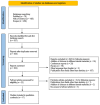Dental Resin Composites Modified with Chitosan: A Systematic Review
- PMID: 40422789
- PMCID: PMC12113295
- DOI: 10.3390/md23050199
Dental Resin Composites Modified with Chitosan: A Systematic Review
Abstract
Objective: This systematic review aims to evaluate the impact of incorporating chitosan into dental resin composites on their mechanical, antibacterial, and physicochemical properties.
Methods: A comprehensive search of PubMed, Scopus, and Web of Science databases was conducted in March 2025 using the following keywords: resin, composite, and chitosan. The inclusion criteria comprised in vitro studies in dentistry evaluating chitosan as a composite additive with full-text availability in English. Data extraction and quality assessment were performed independently by multiple reviewers using standardized tools, and study quality was assessed based on predefined criteria.
Results: Seventeen studies met the inclusion criteria. Chitosan concentrations in the composites ranged from 0.25 wt% to 20 wt%. Antibacterial activity was confirmed in six studies, especially against S. mutans, S. sanguinis, and L. acidophilus. Mechanical properties such as fracture toughness, hardness, and compressive strength were generally improved at lower concentrations of chitosan. However, increased chitosan levels were associated with decreased flexural strength and increased microleakage. Shear bond strength (SBS) was unaffected by chitosan in low concentrations (up to 0.25%), while higher concentrations reduced SBS. Fluoride release capacity was assessed in one study, with no significant differences observed.
Conclusion: Chitosan-modified dental resin composites exhibit promising antibacterial and mechanical enhancements at low concentrations. However, higher chitosan levels may compromise certain mechanical and adhesive properties. These findings suggest a need for standardized methodologies and further research on long-term clinical implications and fluoride release.
Keywords: antibacterial; chitosan; mechanical properties; resin composite.
Conflict of interest statement
The authors state that there are no conflicts of interest related to this study.
Figures
References
-
- Elfakhri F., Alkahtani R., Li C., Khaliq J. Influence of filler characteristics on the performance of dental composites: A comprehensive review. Pt ACeram. Int. 2022;48:27280–27294. doi: 10.1016/j.ceramint.2022.06.314. - DOI
Publication types
MeSH terms
Substances
LinkOut - more resources
Full Text Sources
Medical
Miscellaneous



